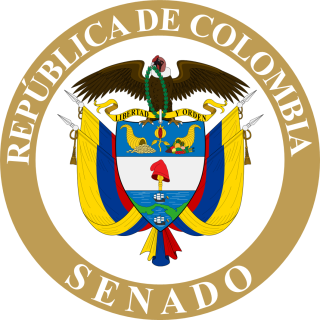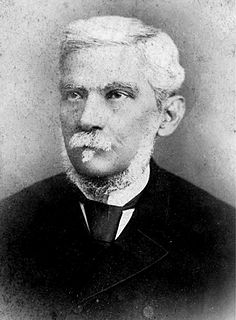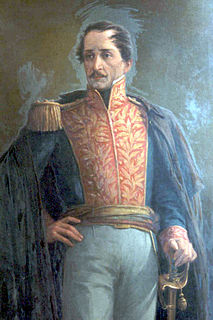
The President of Colombia, officially known as the President of the Republic of Colombia is the head of state and head of government of Colombia. The office of president was established upon the ratification of the Constitution of 1819, by the Congress of Angostura, convened in December 1819, when Colombia was the "Gran Colombia". The first president, General Simón Bolívar, took office in 1819. His position, initially self-proclaimed, was subsequently ratified by Congress.

The Senate of the Republic of Colombia is the upper house of the Congress of Colombia, with the lower house being the House of Representatives. The Senate has 108 members elected for concurrent (non-rotating) four-year terms.

The House of Representatives is the lower house of the Congress of Colombia.

Bartolomé Calvo Díaz de Lamadrid was a Colombian lawyer, journalist, and statesman, who became President of the Granadine Confederation, in what is now Colombia, in 1861 in his role as Inspector General, because no elections were held on that year to decide the presidency. He also served as Governor of Panama and Ambassador to Ecuador, and worked in a number of newspapers.

The constitutional history of Colombia is the process of formation and evolution of the different constitutions that Colombia has had since its formation.

The election of president and vice president of the United States is an indirect election in which citizens of the United States who are registered to vote in one of the 50 U.S. states or in Washington, D.C. cast ballots not directly for those offices, but instead for members of the U.S. Electoral College, known as electors. These electors then in turn cast direct votes, known as electoral votes, for president, and for vice president. The candidate who receives an absolute majority of electoral votes is then elected to that office. If no candidate receives an absolute majority of the votes for President, the House of Representatives chooses the winner; if no one receives an absolute majority of the votes for Vice President, then the Senate chooses the winner.

Presidential elections were held in Colombia on May 25, 2014. Since no candidate received 50% of the vote in the first round, a run-off between the two candidates with the most votes took place three weeks later on June 15, 2014. According to the official figures released by the National Registry office, as of May 22, 2014 32,975,158 Colombians were registered and entitled to vote in the 2014 presidential election, including 545,976 Colombians resident abroad. Incumbent president Juan Manuel Santos was allowed to run for a second consecutive term. In the first round, Santos and Óscar Iván Zuluaga of the Democratic Center were the two highest-polling candidates and were the contestants in the June 15 run-off. In the second round, Santos was re-elected president, gaining 50.95% of the vote compared with 45.00% for Zuluaga.

Presidential elections were held in the United States of Colombia in 1864. The Liberal Party was the only party to nominate candidates, and the result was a victory for Manuel Murillo Toro.

Presidential elections were held in the United States of Colombia in February 1866. The result was a victory for Tomás Cipriano de Mosquera of the Liberal Party.

Presidential elections were held in the United States of Colombia in 1868. The result was a victory for Santos Gutiérrez of the Liberal Party.

Presidential elections were held in the United States of Colombia in 1870. The result was a victory for Eustorgio Salgar of the Liberal Party.

Presidential elections were held in the United States of Colombia in 1872. The result was a victory for Manuel Murillo Toro of the Liberal Party.

Presidential elections were held in the United States of Colombia in 1874. The result was a victory for Santiago Pérez de Manosalbas of the Liberal Party.

Presidential elections were held in the United States of Colombia in 1876. The result was a victory for Aquileo Parra of the Liberal Party.

Presidential elections were held in the United States of Colombia in 1878. The result was a victory for Julián Trujillo Largacha of the Liberal Party.

Presidential elections were held in the United States of Colombia in 1880. The result was a victory for Rafael Núñez of the Liberal Party.

Presidential elections were held in the United States of Colombia in 1882. The result was a victory for Francisco Javier Zaldúa of the Liberal Party.

Presidential elections were held in the United States of Colombia in 1884. The result was a victory for Rafael Núñez of the Liberal Party.
In the United States, a contingent election is the procedure used in presidential elections in the case where no candidate wins an absolute majority of votes in the Electoral College, the constitutional mechanism for electing the President and the Vice President of the United States. A contingent election for the president is decided by a vote of the United States House of Representatives, and the contingent election for the vice president is decided by a vote of the United States Senate. The contingent election procedure, along with the other parts of the presidential election process, was first established in Article Two, Section 1, Clause 3 of the United States Constitution, and then modified by the 12th Amendment in 1804.












